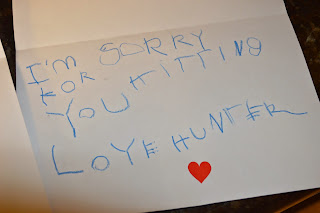EEG Results
I called the neurology office because I still hadn't heard the results from Hunter's EEG last Thursday. The nurse called me back after hours tonight and told me that although they hadn't received the official report, she had looked in the computer and found NORMAL results. The findings included "awake and drowsy" states. Whew! First of all, I am so incredibly relieved that he is not having seizures...his blank stares are just that- staring and thinking. Many children with autism have seizures that can be obvious (generalized tonic-clonic or 'grand mal' seizures) or subtle (such as a blank stare with altered responsiveness) (source: Neurology Wellness). A good neurologist will always recommend an EEG to rule out seizure activity, which the majority of time would have to be controlled with medication. Childhood epilepsy is frightening; there is abnormal activity in the brain, and it can be frequent and recurrent.
So two hypotheses ruled out in the last two weeks. No abnormalities in his brain. No tumors or inflammation recorded in the MRI. No seizure activity while awake and also in a drowsy state.
So what is it? Just a plain, old Autism Spectrum Disorder?
I can't settle for that. I feel like I repeat myself frequently in blog posts, looking for an answer that might never be there. I just need to continue to be a thinking mom and be extremely conscientious of any slight changes that I see.
I asked the nurse what the next step was as far as follow up with Dr. G, regarding her hypothesis of PANDAS. She told me she would get back to me after speaking with the neurologist tomorrow.
I am so very relieved that medically Hunter checks out, as far as his brain is concerned. I am relieved that he doesn't need to be on medication to control abnormal brain activity. I am relieved that I don't need to be concerned with the blank stares.
I am so saddened that I am left in a world of wonder. Although I want the ultimate best for Hunter, I also wanted an answer...because if there is an answer, there's a way to fix it, right? Mathematics 101: Here's the problem, here's the facts, now go and solve it.
Purplemath.com lists several steps to solving a problem.
"The first step to effectively translating and solving word problems is to read the problem entirely. Don't start trying to solve anything when you've only read half a sentence. Try first to get a feel for the whole problem; try first to see what information you have, and what you still need."
I need to understand every aspect, every situational factor that contributed to the whole problem..and then determine the information that I still need. I need to fully consider hypotheses and research all aspects, and not read half an article to form an opinion.
"The second step is to work in an organized manner. Figure out what you need but don't have, and name things. Pick variables to stand for the unknowns, clearly labeling these variables with what they stand for. Explain your reasoning as you go along. And make sure you know just exactly what the problem is actually asking for. "
I need to consider all of the variables and determine what they stand for. I need to explain my reasoning to professionals, doctors, and family and friends. But do I know exactly what I am looking for? Will I someday realize after all of the research, the doctors visits, and the evaluations that I no longer have any idea what "x" stands for? For now, I have two medical professionals who believe in PANDAS and the role it played in bringing us to the PDD-NOS diagnosis we have today. Even though it is controversial, it is still worth consideration, especially when you see other families experiencing the same downward spiral that we have seen. Please take the time, if interested, to view the brief PANDAS video below. If PANDAS is not the answer to the problem, then it sure is a variable in the equation of the world of unknowns. http://www.youtube.com/watch?v=gYaT_DGEaYE&sns=em
So two hypotheses ruled out in the last two weeks. No abnormalities in his brain. No tumors or inflammation recorded in the MRI. No seizure activity while awake and also in a drowsy state.
So what is it? Just a plain, old Autism Spectrum Disorder?
I can't settle for that. I feel like I repeat myself frequently in blog posts, looking for an answer that might never be there. I just need to continue to be a thinking mom and be extremely conscientious of any slight changes that I see.
I asked the nurse what the next step was as far as follow up with Dr. G, regarding her hypothesis of PANDAS. She told me she would get back to me after speaking with the neurologist tomorrow.
I am so very relieved that medically Hunter checks out, as far as his brain is concerned. I am relieved that he doesn't need to be on medication to control abnormal brain activity. I am relieved that I don't need to be concerned with the blank stares.
I am so saddened that I am left in a world of wonder. Although I want the ultimate best for Hunter, I also wanted an answer...because if there is an answer, there's a way to fix it, right? Mathematics 101: Here's the problem, here's the facts, now go and solve it.
Purplemath.com lists several steps to solving a problem.
"The first step to effectively translating and solving word problems is to read the problem entirely. Don't start trying to solve anything when you've only read half a sentence. Try first to get a feel for the whole problem; try first to see what information you have, and what you still need."
I need to understand every aspect, every situational factor that contributed to the whole problem..and then determine the information that I still need. I need to fully consider hypotheses and research all aspects, and not read half an article to form an opinion.
"The second step is to work in an organized manner. Figure out what you need but don't have, and name things. Pick variables to stand for the unknowns, clearly labeling these variables with what they stand for. Explain your reasoning as you go along. And make sure you know just exactly what the problem is actually asking for. "
I need to consider all of the variables and determine what they stand for. I need to explain my reasoning to professionals, doctors, and family and friends. But do I know exactly what I am looking for? Will I someday realize after all of the research, the doctors visits, and the evaluations that I no longer have any idea what "x" stands for? For now, I have two medical professionals who believe in PANDAS and the role it played in bringing us to the PDD-NOS diagnosis we have today. Even though it is controversial, it is still worth consideration, especially when you see other families experiencing the same downward spiral that we have seen. Please take the time, if interested, to view the brief PANDAS video below. If PANDAS is not the answer to the problem, then it sure is a variable in the equation of the world of unknowns. http://www.youtube.com/watch?v=gYaT_DGEaYE&sns=em


Comments
Post a Comment